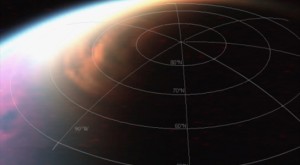Titan, Saturn’s largest moon is finally unravelled in detail
Monday, March 12th, 2012 6:53:40 by Taimoor Tariq
Titan is the largest moon of Saturn which is one of the most coldest places in our solar system, a new collection of 13 studies on Titan reveal craters and rivers that were previously undetected have now been unravelled in detail
The studies have also revealed new details about the moon’s eerie 29.5-Earth-year-long seasonal cycle.
These findings came from almost 8 years of observations conducted by NASA’s Cassini spacecraft in the Saturn system. Ralph Lorenz of the John Hopkins University’s Applied Physics Laboratory, was the co-author of these studies that were published in the journal
Planetary and Space Science.
Cassini began her tour of Saturn in July 2004 and showcased the hazy clouds that were made up of ethane and methane. Titan’s lake-covered North Pole was shrouded by these clouds. The haze layer dropped in 2009 which allowed the astronomers to use Cassini’s
optical and infrared instruments to probe the moon.
The dynamic atmospheric veil has allowed Cassini to partially map Titan, which is marked by craters left by asteroids, comets, and meteorites. Planetary scientists have identified a strange, ring-shaped feature called Paxsi on August 25th, 2009. It wasn’t
until 2012 that it was confirmed that this was a 75-mile wide impact crater.
Other craters on Titan are between 1 billion and 200 hundred million years old. This indicates that the surface of Titan is relatively young. The surface is studded with lakes and rivers in which liquid hydrocarbons flow. Ethane and methane are found in
gaseous form on Earth but on Titan, where surface temperatures hover at around -291?F (93.7?K), the compounds coalesce into liquids.
Lorenz hopes to launch a nuclear-powered robotic boat in 2016 called the Titan Mare Explorer (TiME) into the Sea of Ligeia.
Titan’s atmosphere is twice as thick as the Earth’s, making it difficult for astronomical instruments to image its surface in the visible light spectrum. Researchers had to combine several image data sets to get the most accurate map of Titan yet.
Doppler tracking has allowed them to measure Titan’s gravitational field, which has given the researchers an idea of the internal composition of Titan. The layers include a water-ice crust, subsurface ocean, a shell of high-pressure and a rocky interior.
Tags: Cassini, ethane, hydrocarbon, lake, methane, NASA, Saturn, solar system, Storyline, The Bourne Conspiracy, titan
Short URL: https://www.newspakistan.pk/?p=15533

















